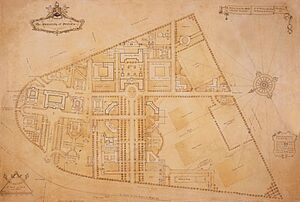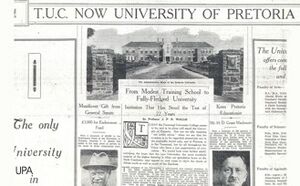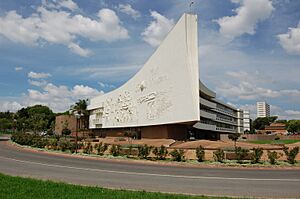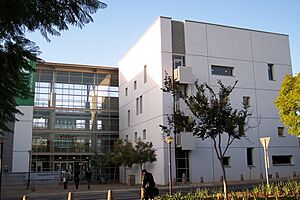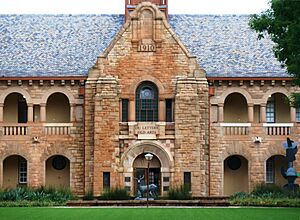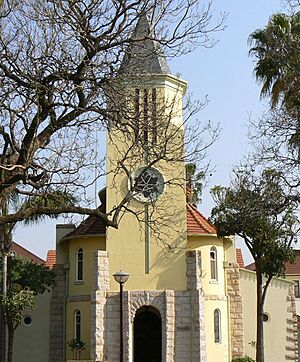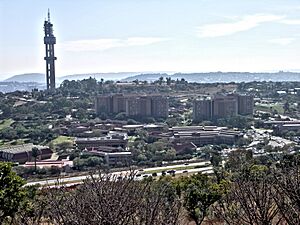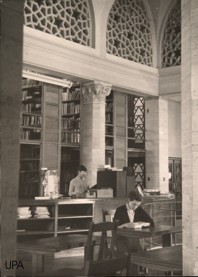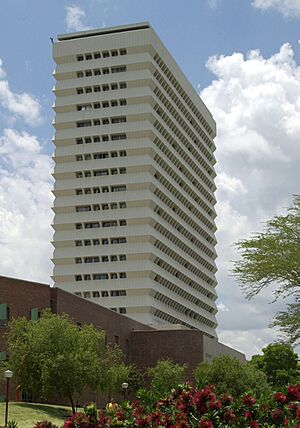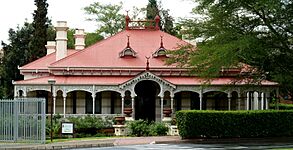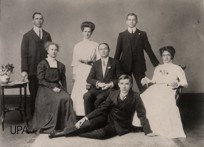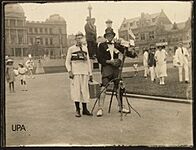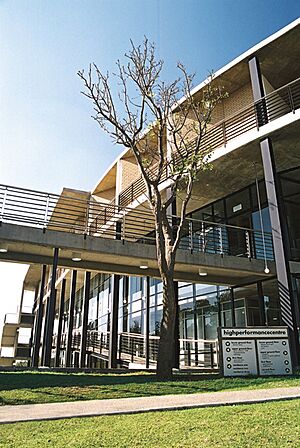University of Pretoria facts for kids
|
|
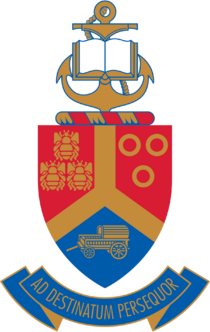 |
|
|
Other name
|
Tuks or Tukkies |
|---|---|
|
Former names
|
Transvaal University College (1908–1930) |
| Motto | Ad destinatum persequor (Latin) |
|
Motto in English
|
"With zeal and perseverance, strive towards the goal" |
| Type | Public research university |
| Established | 4 March 1908 |
| Affiliation |
|
| Endowment | R 7.4 billion (2022) |
| Chancellor | Sisi Khampepe |
| Vice-Chancellor | Francis Petersen |
| Chairperson of Council | Kuseni Dlamini |
|
Administrative staff
|
13,814 (full-time) |
| Students |
|
| Undergraduates | 35,942 |
| Postgraduates | 12,541 |
| Location |
,
,
South Africa
|
| Campus | 7 suburban campuses and facilities, 1,120 hectares (2,800 acres) |
| Colours | Blue, gold, and red |
The University of Pretoria (also called UP, Tuks, or Tukkies) is a large public university in Pretoria, South Africa. Pretoria is the country's administrative capital. The university started in 1908 with just 32 students. It was first part of the Transvaal University College in Johannesburg. Over the years, it grew a lot. By 2019, it had about 53,000 students. The university is spread across seven campuses.
UP has nine main departments, called faculties, and a business school. Its veterinary school, started in 1920, is the only one in South Africa. The university also launched the first MBA (Master of Business Administration) program outside North America in 1949. Its business school, the Gordon Institute of Business Science (GIBS), is often ranked as the best in Africa for executive education.
The University of Pretoria is known for its research. Since 1997, it has produced more research than any other higher education institution in South Africa. In 2008, it awarded the most master's and doctorate degrees in the country. Many of its researchers are among the top 1% in the world.
Contents
History of UP
How it Started: 1889–1929
The day might come when the Transvaal University College might mean to the Transvaal what Oxford University has meant to England. A long time might have to pass, and for a hundred years we might have to watch the grass growing on our lawns before that day arrives, but noble beginning has been made.
The idea for a university in Pretoria came up in 1889. But the Anglo–Boer War (1899-1902) put a stop to it. In 1904, a school called the Transvaal Technical Institute moved to Johannesburg. It was later renamed Transvaal University College (TUC). In 1908, the TUC opened a new campus in Pretoria. This campus offered courses in languages, sciences, and law. This was the beginning of the University of Pretoria.
The first classes were held in a Victorian house called Kya Rosa on Skinner Street. There were 32 students, 4 professors, and 3 lecturers. In 1910, the Pretoria campus became its own independent school. It kept the name Transvaal University College until 1930. The main campus in Hatfield was started in 1910. The Old Arts Building, known for its unique architectural style, was the first building there. People started calling the university "Tukkies" or "Tuks" from the Afrikaans name for the college.
In the 1910s and 1920s, the university grew. It added new study areas like agriculture (1917), theology (1918), economics (1919), veterinary science (1920), and music (1923).
Growing Bigger: 1929–1982
On October 10, 1930, the Transvaal University College officially became the University of Pretoria. At first, the university taught in both English and Afrikaans. But by 1932, Afrikaans became the main language of teaching. As more students joined, new buildings were needed. The Medical Faculty was added in 1943.
During this time, many student activities began. These included the annual Spring Day and sports competitions. Student newspapers like Trek and Die Perdeby also started. From 1948 to 1982, the university grew a lot, with many new buildings added to the Hatfield campus. In the 1960s, the university bought more land to expand.
In 1949, the university also started its Graduate School of Management (GSM).
Modern Changes: 1982 and Beyond
From 1982 to 2008, the university changed to become more open and welcoming to students from all backgrounds. In 1989, it was officially opened to students of all races. A new language policy in 1994 made it a bilingual university again. However, in 2019, the university decided to use only English for teaching.
In 1999, the two veterinary science faculties in South Africa, one at UP and one at Medunsa, joined together. This meant UP's Onderstepoort campus became the only place in South Africa to study veterinary science. In 2000, the Teachers Training College Pretoria joined the university. Its Faculty of Education moved to the Groenkloof campus.
The Gordon Institute of Business Science (GIBS) was set up in Johannesburg in 2000. This was made possible by a big donation from Sir Donald Gordon. GIBS continued the university's tradition of offering MBA programs. In 2004, the Vista University's Mamelodi campus also became part of UP.
How UP is Run
Leadership and Structure
| Faculty founding | |
|---|---|
| Faculty | Year founded |
|
|
|
| Faculty of Economic and Management Sciences | 1920 |
| Faculty of Education | 1902 |
| Engineering, Built Environment and Information Technology | 1908 |
| Faculty of Health Sciences | 1943 |
| Faculty of Humanities | 1908 |
| Faculty of Law | 1908 |
| Faculty of Natural and Agricultural Sciences | 1917 |
| Faculty of Theology | 1919 |
| Faculty of Veterinary Science | 1920 |
| Gordon Institute of Business Science | 2000 |
The university is managed by a council. The vice-chancellor, Professor Francis Petersen, is in charge of daily operations. The chancellor, Justice Sisi Khampempe, is the head of the university in name. The registrar handles academic matters and legal issues.
The university has nine faculties and one business school. These are divided into 140 departments and many research centers.
Main Campus
Hatfield Campus
The main campus of the University of Pretoria is in Hatfield, Pretoria. It is home to six of the nine faculties. This campus covers about 24 hectares and has over 60 buildings that are important historically.
Next to the Hatfield campus is the Hillcrest campus. This is where the High Performance Centre and LC de Villiers Sports Grounds are located. These sports facilities cover 76 hectares. The university also has an experimental farm nearby for agricultural research. The Hatfield campus is connected to the Hatfield Gautrain station, which links Pretoria and Johannesburg. There are also bus services between the campuses.
Museums and Art
The university has a large collection of art. It includes paintings, sculptures, and graphic works by famous South African artists. There are also artworks by well-known international artists. The university's sculpture collection is the biggest in South Africa.
The Old Arts Building, a heritage site, houses special collections. These include the Van Tilburg Collection, Van Gybland-Oosterhoff Collection, and the Mapungubwe Collection.
What survives are the almost untouched remains of the palace sites and also the entire settlement area dependent upon them, as well as two earlier capital sites, the whole presenting an unrivalled picture of the development of social and political structures over some 400 years.
The university looks after the amazing artifacts found at the Mapungubwe National Park. These include gold ornaments, ivory, and ancient pottery. They are on display at the Javett Art Centre. The Van Gybland-Oosterhoff Collection is a large collection of items related to Dutch culture.
The Old Merensky Library has the Edoardo Villa Museum. This museum has the largest collection of sculptures by the Italian artist Edoardo Villa. It also features works by Anton van Wouw and a huge painting by Alexis Preller.
Other art collections include the Christo Coetzee collection, the NKP Ceramics Collection, and the Mimi Coertse Collection.
The university also has Sci-Enza, a Science, Engineering and Technology (SET) Discovery Centre. It opened in 1977. Sci-Enza is a fun place for kids and adults to learn about science and technology. It has a digital planetarium, an exploratorium, and a camera obscura.
Important Places
The Aula is the university's main hall for ceremonies. It was finished in 1958 and was the first opera house in Pretoria. It has hosted many important people and artists. The Musaion (a 500-seat music complex) and the Amphitheatre (a 3000-seat outdoor venue) were built between 1960 and 1964. The University Chapel was bought from the Catholic Church in 1980. It was originally built in 1925.
Other Campuses
Onderstepoort Campus
The Onderstepoort campus is where the Faculty of Veterinary Sciences is located. It is about 30 km north-west of the Hatfield campus. The idea of training veterinarians in South Africa came up in the late 1800s. In 1920, Sir Arnold Theiler was appointed to lead veterinary education at Onderstepoort. The first South African veterinarians graduated in 1924.
The Onderstepoort Veterinary Academic Hospital provides medical care for animals. Students help out as part of their training. This is the only place in South Africa that trains veterinarians and veterinary nurses.
Groenkloof Campus
The Groenkloof campus is home to the Faculty of Education. It started as the Pretoria Normal School in 1902, training teachers. In 2000, the Teachers Training College Pretoria joined the university. The Faculty of Education then moved from the main Hatfield campus to the Groenkloof campus.
Prinshof Campus
25°43′57″S 28°12′10″E / 25.73250°S 28.20278°E Students in the Faculty of Health Sciences study at the Prinshof campus. It is next to the Steve Biko Hospital, which is the main hospital for training. Other hospitals like Kalafong Hospital and Weskoppies Psychiatric Hospital are also used for training.
Illovo Campus, Johannesburg
The Gordon Institute of Business Science (GIBS) is the university's business school. It is located in Illovo, Johannesburg. It also has a satellite campus in downtown Johannesburg. GIBS Europe offers programs from London, United Kingdom.
Other Locations
The university also has satellite campuses in Witbank and Hammanskraal. These are used for practical training and community work. The Mamelodi campus joined the university in 2004. It hosts a special BSc degree program and is a center for community engagement.
Academics and Research
Library System
"This country has given me so much that I am only too happy to be allowed to help it to develop and to be able to give back to it a fraction of what it has given to me".
In 1933, the university decided to build a new library. The Old Merensky Library was designed by Gerard Moerdijk. It combines several architectural styles. It was declared a special heritage site in 1991.
Even with expansions, the Old Merensky Library became too small. So, in 1975, the Merensky Library II was completed. It now holds 7 of the 9 faculty libraries. The university library system also includes specialized libraries like the Jotello F Soga Library (Veterinary Science) and the Oliver R Tambo Law Library.
The Oliver R Tambo Law Library has a very complete collection of legal materials from African countries. The Jotello F Soga Library at the Onderstepoort campus is named after the first South African to become a veterinary surgeon, Dr Jotello Festiri Soga.
In 2006, the university created UPSpace, its own online research library. The university's library is also a partner in the World Digital Library project.
Research at UP
The University of Pretoria is a top research university in South Africa. It works with businesses, industries, and other organizations. It produces many graduates, especially those with master's and doctorate degrees. This research helps South Africa become more competitive. The university is also part of the CDIO Initiative, which is an international group focused on engineering education.
Some important research centers at UP include:
- Centre for Human Rights
- Forestry and Agricultural Biotechnology Institute (FABI)
- African Centre for Genome Technologies
Online Research Collections
UPSpace
UPSpace is the University of Pretoria's online collection of research. It was created to manage and share digital materials from the university. UPSpace contains research articles, historical materials, conference papers, and more. In August 2021, UPSpace was ranked 130th in the world for institutional repositories.
Reputation and Rankings
| University rankings | |
|---|---|
| Global – Overall | |
| ARWU World | 401–500 (2023) |
| QS World | =362 (2026) |
| THE World | 501–600 (2024) |
The University of Pretoria is highly ranked among universities in South Africa and globally.
| UP Times Higher Education Ranking 2016 to 2024 | |
|---|---|
| Year | World Rank |
| 2024 | 501–600 |
| 2023 | 801–1000 |
| 2022 | 601–800 |
| 2021 | 601–800 |
| 2020 | 601–800 |
| 2019 | 601–800 |
| 2018 | 601–800 |
| 2017 | 601-800 |
| 2016 | 501-600 |
The QS World University Rankings also ranks the university well in different subjects. For example, in 2020, it was ranked 51–100 in Agriculture & Forestry and Theology.
The Gordon Institute of Business Science (GIBS) is also highly ranked by the Financial Times for its Executive MBA and Executive Education programs. In 2019, GIBS was in the top 100 for its Executive MBA.
In January 2015, Webometrics ranked the university as the 3rd best in South Africa and 4th in Africa.
Student Life at UP
Where Students Live
The university offers housing in 24 residences for undergraduate and postgraduate students. The first students lived in the Kya Rosa house. The first male residence, Kollegetehuis, was built in 1915. The first female residence, Asterhof, was built in 1925. Students who don't live in residences can join "Day Houses" like Docendo or Dregeana. These groups let them take part in student activities.
Student Groups
There are over 100 student clubs and organizations at the university. These include student government groups like the Student Parliament and the Student Representative Council (SRC). The SRC helps manage student life and represents students' interests. There are also many clubs for different interests, like religious, political, social, cultural, and academic groups.
Fun Student Activities
The University of Pretoria has many fun traditions. One belief is that if a blossom from a Jacaranda tree falls on your head, you will do well in your exams!
The university started the tradition of Rag (student society) (Jool in Afrikaans) in South Africa in 1925. During Rag, students build floats and parade through the streets. They collect money for charity.
Spring Day is a special university holiday held every year in September. Students also take part in song and dance competitions like Insync and Serenade. The Drama Department hosts the Krêkvars Arts Festival every July.
The university has several music groups, including the UP Symphony Orchestra (UPSO), UP Chorale, and UP Youth choir. It also hosts the annual National Youth Orchestra course.
Students also participate in engineering competitions. The university organizes the annual Baja SAE competition. Here, engineering students design, build, and race small off-road cars.
University Mascot
Oom Gert (which means Uncle Gert in Afrikaans) has been the official university mascot since 1929. He is famous for being a target of playful "kidnappings" by rival universities.
Student Media
The Perdeby (meaning The Wasp) is the official university newspaper. It started in 1939 and is read by about 30,000 people. Tuks FM (107.2 FM) is the campus radio station. It started in 1981 and is run by students.
Community Service
The university helps communities through civic service programs. These programs use the university's skills in areas like business and management. They focus on helping developing communities.
Sports at UP
The University of Pretoria has a long history of student involvement in sports. It has 30 registered sports clubs and 10 academies. About 9,000 students take part in sports every year. In 2007, the university produced many top athletes, including 93 Senior Proteas and Springboks.
The university's sports facilities are on the Hillcrest campus. They include the LC de Villiers Sports Grounds and the High Performance Centre (HPC). The HPC was built in 2002. It is a popular place for Team South Africa to train before competitions. It also hosts athletes and teams for pre-season training. The HPC includes the Institute for Sport Research and a Sport Science and Medical Unit.
The HPC also has the TuksSport High School, which started in 2002. This school helps students in Grades 8-12 train in sports while still getting their education.
Rugby
Rugby is a very popular sport at UP. There are competitions between student residences and faculties. The university also plays in national competitions like the Varsity Cup tournament. In 2012 and 2013, the university won the Varsity Cup.
The Tuks Rugby League Football Club also plays in the Rhino Cup and Protea Cup. In the 2012–13 season, both their teams won their respective finals.
Mind Sports
The university has a very active Mind Sports club, started in 2013. This club is part of Mind Sports South Africa. In 2014, 12 gamers from the club qualified for the National Team Trials. The club has become the top university club in South Africa for mind sports.
Football
In 2002, the university started the Tuks Football Academy. The University of Pretoria F.C. team quickly moved up through the leagues. In the 2008–09 season, they reached the Nedbank Cup final. After the 2011/2012 season, the team was promoted to the Premier Soccer League (PSL), which is the top football league in South Africa.
Famous Alumni and People
Over its history, the University of Pretoria has had more than 250,000 graduates. Many of them have become very successful.
In business, alumni include CEOs of major companies. Dr. Anton Rupert was a famous South African businessman and founder of the Rembrandt Group. He was honored as "Tukkie of the century." Marius Kloppers was the CEO of BHP, one of the world's largest mining companies. Johan De Nysschen was president of Audi America. Russell Loubser was the former CEO of the Johannesburg Stock Exchange. Meyer Kahn is the Chairman of SABMiller, the second-largest brewing company in the world.
In law, many alumni have become judges in South Africa's highest courts. Johann van der Westhuizen is a judge in the Constitutional Court. Christof Heyns was a professor of human rights law and a United Nations Special Rapporteur. Dire Tladi is a member of the United Nations International Law Commission.
In theology, alumni include important religious figures. Albert Geyser was a scholar who spoke out against apartheid. Johan Heyns was an influential theologian who was sadly assassinated. Nelson Mandela called him a "martyr for his country and a soldier of peace."
Many famous sports personalities have also studied at UP. These include Springboks like coach Heyneke Meyer and former captains Victor Matfield, Wynand Claassen, Naas Botha, and Joost van der Westhuizen. Other notable athletes include Caster Semenya, Tatjana Schoenmaker, and Oscar Pistorius.
Disputes
In 2022, the university had a disagreement with the City of Tshwane over unpaid bills. The city threatened to cut off water and power to the Hillcrest campus. The university paid the amount, stating that cutting services would harm student residences, research equipment, and animals.
Notable Faculty
- Theo Akkermann (1907–1982), German sculptor
- Conrad J. Wethmar, systematic theologian
- Johan Heyns, systematic theologian
- Lavagnon Ika, management scientist
- Shudufhadzo Musida, Miss South Africa 2020
- Lalela Mswane, Miss South Africa 2021 and Miss Supranational 2022
See also
 In Spanish: Universidad de Pretoria para niños
In Spanish: Universidad de Pretoria para niños
- Open access in South Africa and List of South African open access repositories



